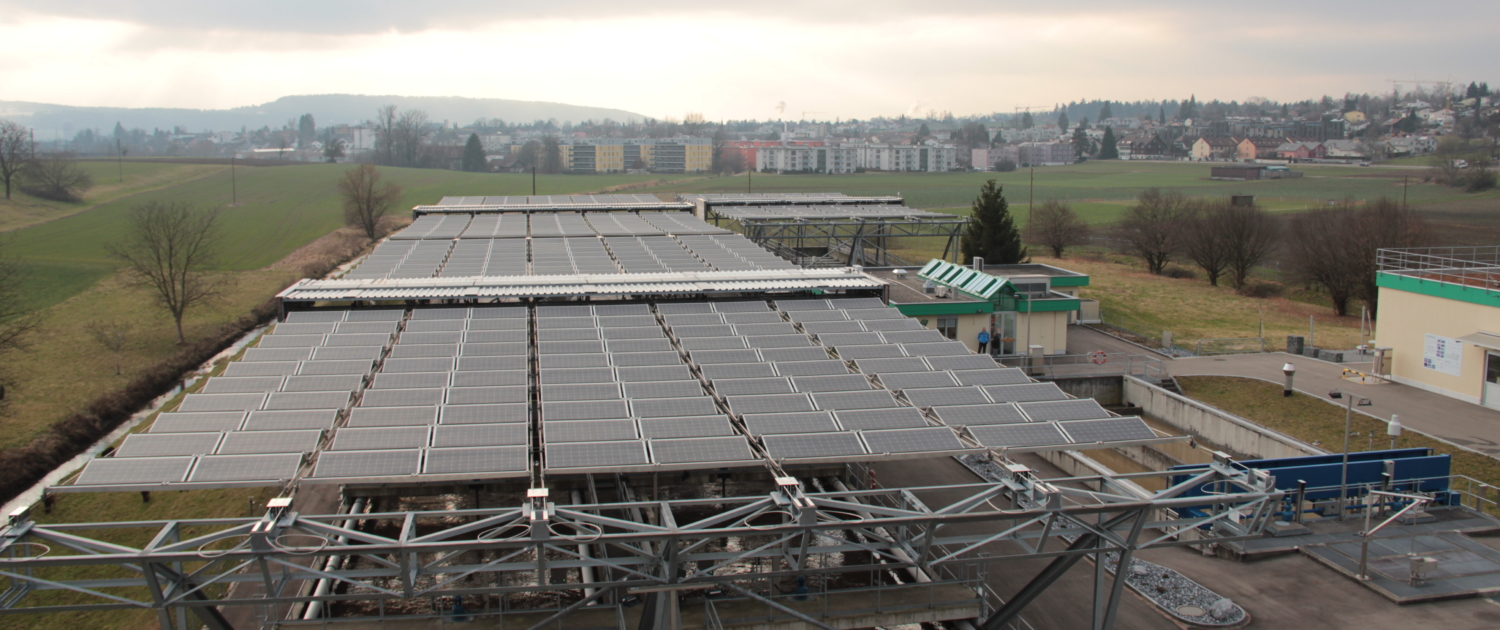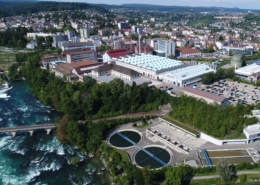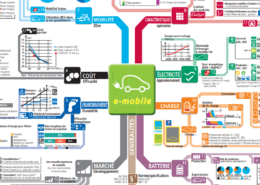Solar folding roof on expansion course
Retract the solar system when it storms or snows, and extend it again when the sun shines. This is how the solar folding roof of the company dhp technology works. The first system was built above the open clarifiers of the Chur wastewater treatment plant. Since then, 12 wastewater treatment plants have been roofed in this way, nine more projects have been ordered and over 30 are in the planning stage. And the folding solar roof is also attracting a great deal of interest in Germany.
How does the solar folding roof work:
At first glance, the solar folding roof looks like a shade roof. The panels are attached to ropes. The supports for the movable structure, which can span large areas, stand far apart so that the space underneath can still be used - with septic tanks or parking spaces.
Video retract and extend
The construction works like the technology used in cable cars, so it is tried and tested. In strong winds, the roof retracts into the so-called "garage" like a hand organ. The whole thing is controlled automatically with local and external weather data. The Grisons-based start-up dhp Technology has already received various awards for this - including the Watt d'Or from the Swiss Federal Office of Energy in 2019.
How is the solar folding roof received?
Patrick Sonderegger is the operations manager at ARA Eich in Bassersdorf near Zurich. The ARA treats the wastewater of nearly 22,000 inhabitants. Since October 2020, a solar folding roof with 1024 panels has been covering some clarifiers with an area of about 3423m2. in 2021, the solar panels provided 297'000 kWh of electricity. At the planning stage, an output of 280'000 kWh was expected. the plant cost 1.0 million Swiss francs. In the video interview, Patrick Sonderegger explains why this solution was chosen.
Video interview - Patrick Sonderegger
The plant in Bassersdorf had to be retracted around 250 times in 2021 due to weather conditions. In most cases, the wind was the reason. The retraction and extension mechanism has worked well so far, says clarification engineer Patrick Sonderegger. At night, the panels are always in the "garage". Because the clarifiers are covered, less algae also forms.
Dübendorf, Bassersdorf's neighboring municipality, is also considering a folding solar roof for its wastewater treatment plant to produce its own electricity. Jürgen Besmer, city councilor of Dübendorf and chairman of the board of directors of ARA Neugut, was present at an inspection in Bassersdorf in January 2022. The folding solar roof convinced him.
Video Jürgen Besmer
Together with his partner Andreas Hügli, Gian-Andri Diem is the managing director of dhp technology, which produces the solar folding roof. In the last three years, the start-up in Zizers, Grisons, has grown into a small construction company that handles the development, planning, installation and maintenance of the solar systems. Between 2019 and 2022, dhp technology has covered 11 sewage treatment plants and a parking area with a folding solar roof.
Expansion potential would be there. There are 800 wastewater treatment plants in Switzerland alone. In the video interview, Gian-Andri Diem explains why the focus is also on wastewater treatment plants in Germany and what this has to do with the current high electricity prices. And he says how the electric car boom could benefit the construction of solar folding roofs over parking lots.
Video
Incidentally, the first solar folding roof over a parking lot was realized by dhp technology at the Jakobsbad-Kronberg cable car in Appenzell. On an area of about 4'000 m2 with 152 parking spaces 420 kWp power are installed. The electricity is used to operate the cable car.
Crowd investing instead of bank loans:
Dhp technology also took a new approach to raising funds. With a crowd-investing campaign, the company was looking for investors who wanted to get financially involved with dhp technology. A good 1.5 million Swiss francs were raised from almost 450 supporters. This clearly exceeded expectations, says co-managing director Gian-Andri Diem. "We chose this way of raising money because we keep getting requests from people who want to invest in our facilities/our company."
Brigitte Mader, Communications, Swiss Federal Office of Energy
 BFE - Brigitte Mader
BFE - Brigitte Mader
 EVNHWärme aus Abfall und Abwasser hat noch viel Potenzial – Stabübergabe bei InfraWatt
EVNHWärme aus Abfall und Abwasser hat noch viel Potenzial – Stabübergabe bei InfraWatt  Noemi TirroQuel rôle pour la bioénergie dans le secteur de la chaleur?
Noemi TirroQuel rôle pour la bioénergie dans le secteur de la chaleur?  Shutterstock 288462527La recherche énergétique a besoin des sciences humaines et sociales
Shutterstock 288462527La recherche énergétique a besoin des sciences humaines et sociales  ElectrosuisseApprofondir ses bases sur les voitures électriques
ElectrosuisseApprofondir ses bases sur les voitures électriques 
 EnergieSchweiz
EnergieSchweiz Energiejournal
Energiejournal
Dein Kommentar
An Diskussion beteiligen?Hinterlassen Sie uns Ihren Kommentar!